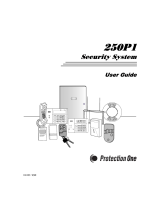
PROTECTING YOUR PREMISES WHILE YOU ARE AWAY
If the three lights on your keypad are blinking, you have lost ac power. Check if there has been
a general power outage, or if the control panel transformer is disconnected. If you must operate
without ac power, hold down Key
[9]
until a beep sounds to stop the lights from blinking. Next,
test your system by holding down Key
[1].
If the alarm doesn’t sound, or is weak, replace the
battery. Always test your system weekly.
Arming The System Before You Leave. Test your system by using Key
[1].
Check the green
Ready light
at the keypad. If it is on, enter your code. The red light
will come
on and the green
light will go off.
Leave immediately through your regular entry door before the delay time runs out. If you wait
too long, the sounder will warn that the entry delay has started. To avoid causing an alarm,
quickly return to the keypad and enter your code to reset the control panel. You may then arm
the system again.
Arming With A Zone In
Trouble.
A flashing green Ready light indicates that at least one
non-24-Hour Zone is in trouble; that is, the zone is in an open condition. If a Day Zone is
open, the zone will also display numerically and the sounder will be pulsing. Any zone in
trouble can be displayed numerically by holding down Key
[3]
until a beep sounds. Try to fix
the zone by closing an open window, door, etc. If a Day Zone is in trouble, reset the Day Zone
indication by holding down Key
[9]
until a beep sounds. The green Ready light will now stay
on and the system may be armed.
If a zone cannot be fixed immediately, it still may be possible to arm without the protection of
that zone. Check with your installer. If Auto-Bypass has been selected for the zone in trouble,
simply arm your system. A short beep will sound at the keypad. This indicates that a zone has
been auto-bypassed, meaning it cannot now cause an alarm.
If the zone has been programmed for Selective Bypass, pressing Key
[B] and then the number
of the zone will manually bypass that zone. Group-Bypass zones are a group of zones that can
all be manually bypassed at the same time simply by pressing Key
[B] twice.
You may use Key
[2]
to numerically display selective or group bypassed zones.
You will not be able to arm your system if
(a)
a zone selected as a Priority Zone is in trouble,
(6)
a Day Zone numerical display indication is still flashing, or
(c)
the three lights are flashing
due to an ac power failure. If you attempt to arm, the sounder will come on and a
“P”
will be
displayed. Enter your code again, and reset the digital display memory or ac failure indication
by holding down Key [9]
,
(
remember to test your system!). Be certain to have all zones in
trouble fixed quickly.
Disarming When You Return. When you enter through the exit/entry door, the sounder will
come on for the entire entry period. If, upon entering, the red Armed light is flashing, leave
the premises and call authorities from a neighbor’s telephone. Disarm the panel quickly using
your Arm/Disarm Code.
If an alarm occurred on a non-24-Hour Zone, the Armed light will be flashing and the zone
number will be displayed on the numerical display, even after you disarm. To reset the display,
hold down Key
[9].
Once the system is disarmed, the red Armed light will go off and the green Ready light will
come on (or flash if a zone is in trouble). If you enter the wrong code, you must wait 2 seconds
before re-entering your code.
If an alarm occurred on a 24-Hour Zone, there will be no indication. Remember, zones that
are in trouble may be displayed by holding down Key
[3].
6










